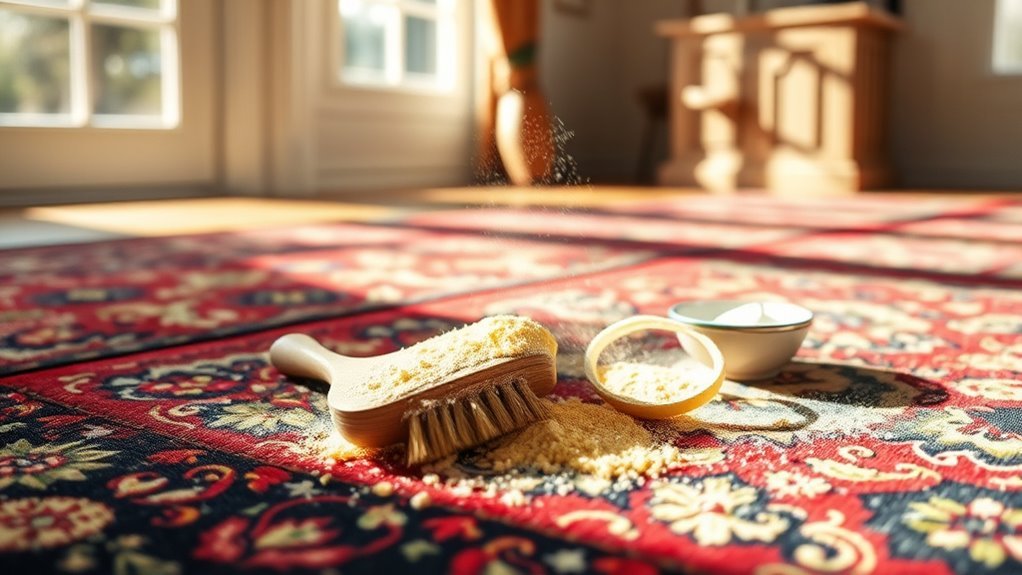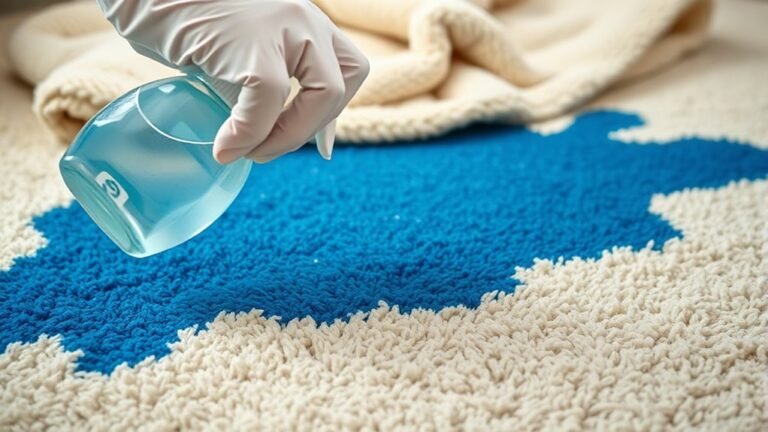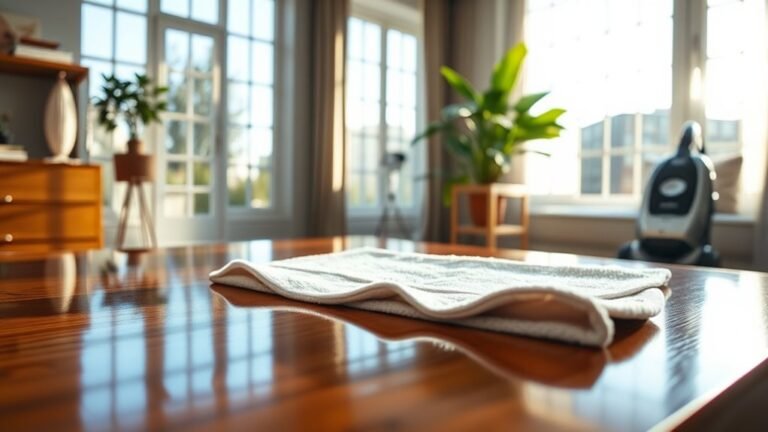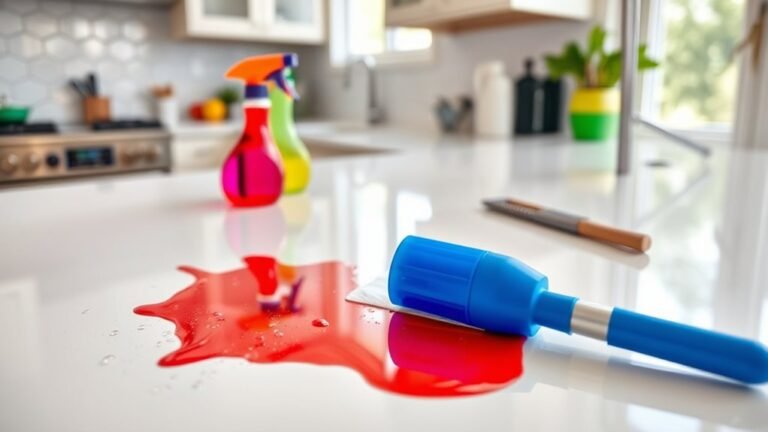Natural Cleaning Hacks for Your Rug
You can freshen your rug naturally by sprinkling baking soda to absorb odors, then vacuuming it up. For stains, try a homemade vinegar and water spray or gently scrub with diluted Castile soap. Brighten colors using lemon juice and remove grease with cornstarch. Quick red wine stains respond well to salt application. Wool rugs benefit from diluted hydrogen peroxide for light stains. Controlling moisture helps prevent mold naturally. Explore further to discover more effective, safe rug care methods.
Using Baking Soda to Eliminate Odors

Although rugs can trap unpleasant odors over time, you can easily freshen them up using baking soda. As a natural odor neutralizer, baking soda effectively absorbs and eliminates smells without harsh chemicals. To use it, sprinkle a generous layer evenly across your rug’s surface. Let it sit for at least 15 minutes, or longer for stronger odors, allowing the baking soda to penetrate fibers. Then, vacuum thoroughly to remove the powder along with trapped odors. This method is simple, non-toxic, and preserves your freedom from synthetic fragrances or cleaners. Regular application keeps your rug smelling fresh and extends its life. You’ll appreciate how baking soda’s natural properties provide a practical, eco-friendly solution for maintaining a clean, odor-free rug environment.
Homemade Vinegar Solution for Stain Removal
One effective natural remedy for tackling stains on your rug is a homemade vinegar solution. Thanks to vinegar properties like acidity and antibacterial effects, it breaks down various stain types without harsh chemicals. To use this solution wisely, follow these steps:
- Mix equal parts white vinegar and water in a spray bottle for a balanced cleaning agent.
- Test the solution on a hidden rug area to verify colorfastness and avoid damage.
- Lightly spray the stained area, let it sit for 5-10 minutes, then blot with a clean cloth to lift the stain.
This method works well on coffee, pet, and food stains, offering a safe, natural alternative that preserves your rug’s integrity and your freedom from synthetic cleaners.
Gentle Scrubbing With Liquid Castile Soap

When you need a gentle yet effective way to clean your rug, liquid Castile soap offers a natural solution that’s both mild and versatile. Start by diluting a few drops of Castile soap in warm water to create a gentle cleaning mixture. Using a soft-bristled brush or cloth, apply the solution to the rug and perform gentle scrubbing in circular motions. This method lifts dirt without damaging fibers, preserving your rug’s texture and color. Avoid over-wetting by using minimal liquid and blot with a clean towel afterward to remove excess moisture. This approach grants you freedom from harsh chemicals while effectively maintaining your rug’s cleanliness. Regular gentle scrubbing with Castile soap keeps your rug fresh, fostering a healthy, natural home environment.
Lemon Juice for Brightening Rug Colors
Beyond gentle cleaning, natural ingredients like lemon juice can enhance your rug’s appearance by brightening its colors. Lemon juice benefits include its natural acidity, which gently lifts stains and revitalizes faded hues without harsh chemicals. To effectively use lemon juice as a brightening technique, follow these steps:
- Dilute fresh lemon juice with equal parts water to avoid over-acidity that might damage fibers.
- Test the mixture on a small, hidden section of your rug to confirm colorfastness.
- Lightly apply the solution with a clean cloth, then blot with a dry towel to absorb excess moisture.
Cornstarch to Absorb Grease and Oil Stains

You’ll want to sprinkle cornstarch generously over the grease or oil stain and let it sit for at least 15 minutes to absorb the residue effectively. Afterward, gently brush off the cornstarch without grinding it deeper into the fibers. Finally, vacuum the area thoroughly to remove any remaining powder and restore your rug’s texture.
Applying Cornstarch Effectively
Although cornstarch might seem like a simple pantry staple, it’s remarkably effective at absorbing grease and oil stains from rugs. To harness cornstarch benefits fully, you need to apply it correctly. Here’s how to maximize cornstarch applications for your cleaning freedom:
- Sprinkle a generous layer of cornstarch directly onto the grease or oil stain, covering it completely.
- Let it sit undisturbed for at least 30 minutes, allowing the cornstarch to penetrate and absorb excess oil.
- Gently brush or vacuum the cornstarch away, checking the stain’s appearance before deciding if a repeat application is needed.
Removing Cornstarch Residue
Once the cornstarch has absorbed the grease or oil, you’ll need to remove every trace of the powder to prevent residue buildup on your rug. Start by gently vacuuming the area with a brush attachment to lift the cornstarch without grinding it deeper. If some residue remains, lightly dampen a clean cloth with water and blot the spot, avoiding rubbing that could spread the stain. For those seeking cornstarch alternatives, baking soda offers similar grease-absorbing benefits and can be removed using the same method. The cornstarch benefits include its natural, non-toxic nature and effectiveness in drawing out oil. By carefully removing the powder, you preserve your rug’s texture and appearance, maintaining freedom from harsh chemicals while keeping your cleaning process simple and effective.
Steam Cleaning With Essential Oils
Steam cleaning with essential oils combines powerful cleaning with natural fragrance, making it an effective method for revitalizing rugs. You’ll enjoy steam benefits like deep dirt removal and sanitization without harsh chemicals. Adding essential oil blends enhances the experience by infusing your rug with a fresh, natural scent while providing antibacterial properties.
Here’s how to do it right:
- Mix a few drops of your preferred essential oil blend (like lavender or eucalyptus) into the steam cleaner’s water tank.
- Test a small rug area to verify colorfastness and avoid damage.
- Slowly steam clean the rug, allowing the steam and oils to penetrate fibers and lift dirt.
This method frees you from synthetic cleaners while keeping your rug fresh and clean.
Dry Cleaning With Club Soda
If you prefer a method that doesn’t involve moisture, dry cleaning with club soda offers an effective alternative for revitalizing your rugs. Club soda benefits include its carbonation and minerals, which help lift stains and dirt without soaking the fibers. To start, sprinkle club soda directly onto the affected area. Let it sit briefly, allowing the bubbles to penetrate and loosen grime. Then, blot gently with a clean cloth—avoid rubbing to prevent fiber damage. For ideal results, use dry cleaning tips like testing a small patch first to verify colorfastness. After blotting, allow the rug to air dry completely. This method preserves your rug’s texture and appearance while giving you a natural, chemical-free cleaning option that supports your desire for freedom from harsh cleaners.
Using Salt to Remove Red Wine Spills
If red wine spills on your rug, you’ll want to act fast to absorb it with salt before it sets. Sprinkle a generous layer directly onto the stain, allowing the salt to soak up the liquid fully. Once the salt has absorbed the wine, you’ll need to vacuum or brush it off and follow up with a gentle cleaning solution to remove any remaining residue.
Absorbing Wine Quickly
When you notice red wine spilled on your rug, acting quickly can prevent a permanent stain. Effective wine absorption methods focus on immediate action to limit penetration. Here are three quick cleanup tips to absorb wine efficiently:
- Blot the spill gently with a clean cloth to soak up excess liquid without spreading it.
- Apply an absorbent substance like salt promptly to draw out the wine from fibers.
- Replace the salt as it darkens to continue absorbing until the spill is mostly lifted.
Salt Application Technique
Although salt is a simple household item, its crystalline structure makes it highly effective at drawing moisture from red wine spills on rugs. To use the salt scrubbing technique, immediately cover the spill generously with coarse salt, allowing it to absorb the liquid. As the salt darkens, it indicates it’s pulling moisture from the fabric fibers. After 10-15 minutes, gently lift the salt away—avoid rubbing to prevent driving the stain deeper. For stubborn marks, you can lightly dampen the salt on a soft cloth and carefully scrub the area in small circles, enhancing salt stain removal without damaging the rug. This method is natural, accessible, and quick, empowering you to tackle red wine spills effectively while preserving your rug’s integrity.
Post-Treatment Cleaning Steps
Once the salt has absorbed the red wine spill, you’ll need to carefully remove any remaining residue to prevent discoloration or fabric damage. Proper post cleaning care is essential for effective rug maintenance. Follow these steps to restore your rug:
- Vacuum Thoroughly: Gently vacuum the salt and dried wine particles without pressing too hard to avoid embedding residue deeper.
- Spot Clean with Cold Water: Lightly dampen a clean cloth with cold water and blot the affected area, avoiding rubbing to preserve fibers.
- Air Dry Completely: Allow the rug to dry naturally in a well-ventilated space to prevent mold growth and maintain fabric integrity.
Incorporating these rug maintenance tips will guarantee your rug stays clean and vibrant after using salt for red wine stain removal.
Refreshing Wool Rugs With Hydrogen Peroxide
Since wool rugs require gentle care to maintain their texture and color, using hydrogen peroxide can be an effective way to refresh them without causing damage. Hydrogen benefits include its natural disinfectant properties and ability to break down stains without harsh chemicals. To apply, dilute hydrogen peroxide with water in a 1:3 ratio to guarantee it’s mild enough for wool care. Test a small, hidden area first to check for any discoloration. Lightly spray the solution over the rug’s surface, then gently blot with a clean cloth. Avoid saturating the fibers to prevent damage. Let the rug air dry completely before using it again. This method revitalizes your wool rug, removing odors and light stains while preserving its natural beauty and softness.
Preventing Mold and Mildew Naturally
If you want to keep your rugs free from mold and mildew, controlling moisture is key. Effective mold prevention starts by reducing dampness and ensuring proper airflow. Here are three natural strategies for mildew prevention:
- Ventilate Regularly: Open windows and use fans to circulate air, preventing moisture buildup beneath rugs.
- Use Natural Absorbents: Place baking soda or charcoal briquettes under rugs to absorb excess humidity naturally.
- Spot Clean with Vinegar: Treat damp spots promptly using a solution of white vinegar and water to inhibit mold growth.
Frequently Asked Questions
How Often Should I Deep Clean My Rug Naturally?
You should follow a frequency schedule of deep cleaning your rug every 6 to 12 months to maintain its appearance and hygiene. This schedule balances cleaning benefits like removing dirt, allergens, and odors without causing wear. If your rug sees heavy foot traffic or pets, consider cleaning it more often. Sticking to this routine helps preserve your rug’s lifespan while giving you the freedom to enjoy a fresh, healthy home environment.
Can Natural Cleaning Harm Delicate Rug Fibers?
You need to be careful with natural cleaning because certain rug fiber types, like wool or silk, can be sensitive. Using a cleaning solution with the wrong pH can damage these delicate fibers, causing discoloration or weakening. Always test your cleaner on a small area first and use mild, pH-neutral solutions. This way, you preserve your rug’s beauty while enjoying the freedom of natural cleaning methods without risking harm.
Which Natural Methods Are Best for Pet Urine Stains?
You know what they say: “A stitch in time saves nine.” For pet urine stains, start by blotting excess moisture. Then, sprinkle baking soda generously to neutralize odor and absorb moisture. Next, spray a vinegar solution—mix equal parts water and white vinegar—to break down stain components. Let it fizz and sit for 10-15 minutes before blotting again. This method’s natural, effective, and keeps your rug fresh without harsh chemicals.
Are Natural Rug Cleaners Safe for Outdoor Rugs?
Yes, natural rug cleaners are generally safe for outdoor rugs, especially when you choose safe cleaning solutions like vinegar, baking soda, or mild castile soap. These ingredients effectively tackle dirt without harsh chemicals that could damage fibers or fade colors. For outdoor rug cleaning, test a small area first, then gently scrub and rinse with water. This method keeps your rug fresh while preserving its durability and your freedom to enjoy a clean, healthy space.
How Do I Test Natural Solutions for Colorfastness?
Testing natural solutions for colorfastness is like tiptoeing through a minefield—you want to avoid surprises. Start by applying a small amount of your cleaner to a hidden rug corner. Let it sit for 10-15 minutes, then blot with a white cloth. If no color transfers, your colorfastness testing is successful. This careful step guarantees your natural solution effectiveness without risking your rug’s vibrancy or freedom to clean confidently.






